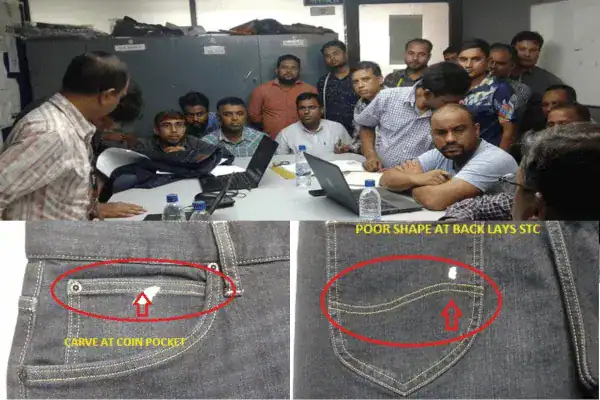Breakdown and Preventive Maintenance of Garments Industry
Breakdown Maintenance and Preventive Maintenance System of Sewing Machines in Garments Manufacturing
The machine is an important resource that is constantly used for adding value to a product. So it is necessary to keep it in the best operating condition. Otherwise, there will be excessive downtime and also interruption of production if is used in the mass production line. Poor working of machinery and equipment will lead to quality-related problems, it’s necessary to maintain the machine in good operating conditions at an economical cost. Here I present the Breakdown Maintenance and Preventive Maintenance System of types of Sewing Machines in the Garments Manufacturing process.

The machine maintenance system is the key factor for garment manufacturing. The factory’s work efficiency depends on machine fitness too. Maintenance is the action to retain or to fix or to restore an item in a state in which it can perform its required function by the combination of all technical administrative, managerial, and supervision actions. In general words, maintenance is the process by which equipment is looked after in such a way that it runs trouble-free. Service and increased machine life can be ensured and specific product quality required by the customer is sustained.
Types of Sewing Machine Maintenance in the Garments Industry:
Generally, there are two types of maintenance systems found in the apparel industry:
- Breakdown Maintenance
- Preventive Maintenance/Routine maintenance
Breakdown Maintenance of Sewing Machine
Breakdown Maintenance is the repair generally done after equipment has attained downstate. Online mechanics set for breakdown maintenance sewing line for immediate support or quick information system can be set to call mechanic, can set traffic lighting system in every sewing line. Breakdown time should be recorded and tracked to see a mechanic’s performance. Machine breakdown time is considered a loss of time in garment manufacturing.
These are unpredictable or reactive types of maintenance and are more difficult to schedule than the above categories. There are no routine maintenance tasks to perform and equipment is repaired or replaced only when obvious problems occur. Breakdown maintenance works well if equipment shutdowns don’t affect product quality or revenue generation.
Preventive maintenance/ Routine maintenance of the Sewing Machine
Preventive maintenance is periodical inspection (daily, weekly, and monthly basis cleaning, inspection, oiling, and re-tightening) and service activities that are aimed at detecting potential failures and performing minor adjustments and repairs that will present major operating problems in the future. The sewing maintenance team does preventive maintenance as per their maintenance schedule or calendar.
It’s the preventive maintenance to retain the healthy condition of equipment and prevent major breakdowns of failure by a deterioration of facilities. It ranges from such simple tasks as cleaning, inspection, equipment condition diagnosis checking, changing oil, water, air, alignment, re-tightening, etc. Routine maintenance consists of periodically inspecting, servicing, lubricating, and cleaning equipment and replacing parts to prevent sudden failure and process problems to ensure continuous working conditions.
Sewing Machine Maintenance equipment:
- Flat screwdriver (Small/ Medium/ Large)
- Star screwdriver (Small/ Large)
- Nose pliers (Large/ Small)
- Sly- Wrench
- Forceps (chimta)
- L- Key Needle
- Needle driver
- L- Keyset
- Daly set
- Lock Pliers
- Hammer (Small/ Large)
- File set
- Tester
- Welding machine
- Air gun
- Vacuum cleaner
Preventive Maintenance Checklist for Single Needle Lockstitch Machine
- Clean Oil Filter
- Needle Condition/ Position
- Thread Sequence
- Oil Level
- Check Spring Operation
- Treadle Looseness/ Operation
- Brake Position
- Belt Tension + Condition.
- Oil Flow to Rotary Hook.
- Thread Stand Tight + Straight.
- Oil Condition.
- Rotary Hook Condition.
- Hook Timing.
- Bobbin Case Thread Tension.
- Feed Dog Height/Condition
- Presser Foot Sole Condition.
- Position Finger Condition
Preventive Maintenance Checklist for OverLock Machine:
- Needle
- Thread Sequence
- Machine Clean
- Oil Level
- Knife Sharpness
- Treadle Looseness/ operation
- Brake Position
- Stitching part check
- Feed dog height
- Oil Condition
- Oil Filter clean
- Check all screws complete clean and test
- Thread stands Straight + Tight
Preventive Maintenance Checklist for Button Attach Machines:
- Needle Position/Condition
- Thread Sequence
- Oil all parts indicated in manual
- Drive belt tension
- Grease gears + clutch
- Clean Machine thoroughly Needle to buttonhole position
- Treadle operation smooth
- Stitching parts timing
Preventive Maintenance Checklist for Bartacking Machine:
- Needle Condition/Position
- Thread Sequence
- Check spring Operation
- Bobbin case threads tension
- Bobbin winder operation
- Throat plate Condition (hole)
- Drive belt Condition/tension
- Oil Machine (as per manual)
- Clean Machine thoroughly
Preventive Maintenance Checklist for Lockstitch Button Hole Machine:
- Thread Stand Straight – Tight
- Needle Condition / Position
- Thread Sequence
- Cutting knife Condition
- Oil Level
- Clean Machine Thoroughly
- Check Oil flow to Rotary Hook
- Check Half-Speed Operation
- Check Upper Trimmer operation
- Bobbin Winder Operation
- Oil Condition
- Drive Belts (3) Condition + Tensional
- Treadle Operations (2)
- Presser Foot Rubber Condition
Sewing Machine Maintenance & Safety Rules Practice in the Garments Industry
Best & regular maintenance of plant machinery increases not only machine life but also quality garments stitching, less consumption of spare parts & reduces the tendency of machine problems result from increased total productivity. In view of the above the machinery maintenance policy & procedure are given below.
1. Daily maintenance: while the sewing floor is running if any machine creates a problem, initially floor mechanics try to fix that machine within the line. If it is not possible in a short time, the machine will be shifted to the maintenance room and replaced by another machine & necessary measures will be taken to fix that Machine. The daily records of maintenance works have been kept in a format.
2. Monthly maintenance: It is preventive maintenance to reduce machinery problems & increase machine life, executed by predetermining a schedule fixed at the start of the year on a regular basis. This maintenance program covers the total servicing of all machines, oil changes, oil filter changes, or any defective parts changes. Records of monthly maintenance work have been kept in a format.
Sewing Machine Preventive Maintenance
Responsibilities of Sewing Machine Operator
- Check threading of the machine→ daily
- Complete cleaning of the machine→ daily
- Keep the Clean paper under the foot→ daily
- Check for oil leaks → Every Four hour
- 5. Clean needle/foot/t. feed bars → Every Four hour
- Clean machine head with → Every Four hour
- Clean machine tabletop→ Every Four hour
- Unusual noise of the machine→ all day
Responsibilities of Sewing machine Mechanic
Daily Basic work of Sewing machine Mechanic:
- Check Machine Setting Correct or Not→ all-day
- Check Oil Level and Oil Leaks of the Machine→ Day starting
- Check the un-usual noise of the machine →All-day
- Check Oil-paper → Day starting
- Check safety Equipment→ Day starting
- Check Machine allocation (According to M/C Layout) → Day starting
- Check Production Plan → Day starting
Monthly basis work Sewing machine Mechanic
- The whole machine clean opening parts
- Back/ Front cover
- Hook/ Looper timing and Needle
- Needle plate
- Feed dog
- Oil lubrication change
- Checking machine fitness to run continuously.
Daily Sewing Machine Check Points
- Tension spring
- Take up spring
- Bobbin case spring
- Thread wiper
- Oil level/ oil leak
- Threading
- Needle plate/ fee dog
- Machine washer
- Laser light
- Needle plate/ fee dog
Monthly Sewing Machine Maintenance/servicing Checklist
- Air device
- Trimmer device
- Super tension post takes up spring
- Needle bar, bus,h, and clam condition
- Needle plate condition
- Feed dog condition
- Winder condition
- Rotary hooks or loopers
- Oil level/ oil filter condition
- The machine table in good condition
- Cleaning and blowing
- The lubricant in equipment (oil and grease cut)
- Main shaft, connecting rod, bearing condition
- The machine head has to be balanced with the base plate
- Knife slide
- Power on/ off switch
- Motor and control box condition
- Abnormal sound Connecting rod and crosshead
Thats all on the details of Breakdown Maintenance and Preventive Maintenance System of Sewing Machines in Garments Manufacturing.



